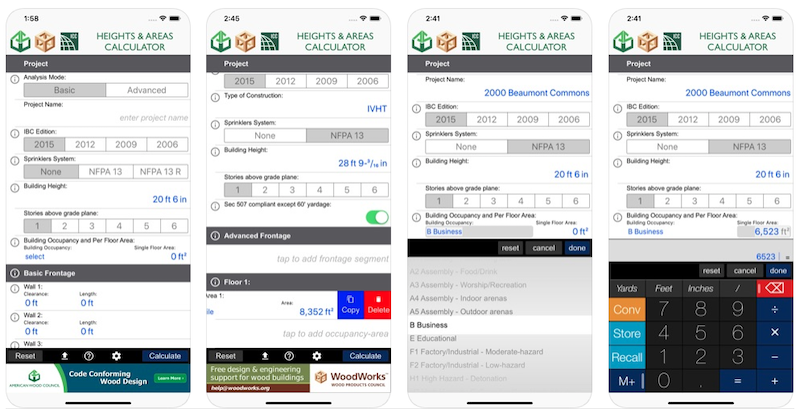A free app that calculates the maximum allowable heights and areas for buildings of various occupancy classifications and types of construction has been released.
The Heights & Areas Calculator, developed by the International Code Council, the American Wood Council, and WoodWorks, is based on provisions in the 2006 to 2015 editions of the International Building Code.
Users can input a given building geometry, site conditions (e.g., open frontage), type of construction, and occupancy.
The tool then shows allowable types of construction that are permitted. The “basic” version of the calculator limits building input to a single occupancy and equal floor areas for the entire building. An “advanced” option permits multiple occupancies and different floor areas.
“We often work with design teams that are exploring wood construction as a way to cost-effectively increase the density of their projects,” said Bill Parsons, vice president of operations for WoodWorks, in a news release. “The new heights and areas app lets building designers quickly determine if they’re maximizing value based on the objectives of the project, and to compare the options available with different construction types.”
Related Stories
Codes and Standards | Feb 27, 2017
Green building saves operating costs and boosts asset value
A new report shows 14% cost savings and a 7% increase in value when green standards are met.
Codes and Standards | Feb 24, 2017
Scant data hampering energy, water efficiency at sports venues
New NIBS report says baseline information needs further development.
Codes and Standards | Feb 22, 2017
Plans for WELL Building Standard include linkage with other green building standards
The planned updated version will be customizable for any building type.
Codes and Standards | Feb 21, 2017
Aging building code inspectors and government belt-tightening could cause crisis
Inspectors are edging toward retirement with no understudies in place.
Codes and Standards | Feb 20, 2017
AISI publishes three new cold-formed steel framing research reports
Seismic simulation, roof trusses, steel-to-steel and sheathing-to-steel connections are examined in the reports.
Codes and Standards | Feb 17, 2017
New energy design guide for metal building systems now available
The second edition incorporates more recent IECC and ASHRAE standards.
Codes and Standards | Feb 14, 2017
Paper outlines how BREEAM credits can be used for WELL standard compliance
The paper provides guidance on how to streamline pursuit of dual certification.
Codes and Standards | Feb 14, 2017
Evidence mounts on health, productivity benefits of sustainable work spaces
High-performance green buildings are linked to better job performance.
Codes and Standards | Feb 13, 2017
Calif. commission approves ‘emergency’ balcony code changes
The changes apply to multifamily, hotels, state-owned buildings, and public schools.
Codes and Standards | Feb 9, 2017
Google-initiated program aims to get construction industry to use healthier building materials
Portico platform features a database of products ranked on how they disclose ingredients.

















